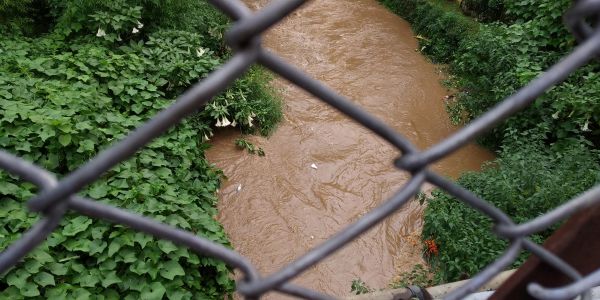Untreated sewage water discharge ruining streams in state
2023-24 report of MSPCB shows sorry state of water bodies; govt. needs to put in place modern sewage discharge system to save rivers

 Rapid urbanisation and a lack of a modern sewage system with treatment plants are leading to heavy pollution of water bodies in Shillong. A recent pollution report shows the dwindling health of the city streams that once were the pride of the place.
Rapid urbanisation and a lack of a modern sewage system with treatment plants are leading to heavy pollution of water bodies in Shillong. A recent pollution report shows the dwindling health of the city streams that once were the pride of the place.
Most of the water bodies — including streams, whose crystal clear waters once quenched the thirst of the local populace — in Meghalaya are polluted to the extent that they cannot be the source of drinking water without conventional treatment and disinfection.
A 2023-24 report of the Meghalaya State Pollution Control Board (MSPCB) shows heavy pollution of water bodies that make them unfit for use without treatment.
The streams in Shillong are, especially, in a poor state. The Umkhrah and Umshyrpi rivers have a negligible dissolved oxygen level, with the minimum value of zero during the dry winter months. The minimum oxygen requirement for the propagation of aquatic life is 5mg/litre, according to the report.
The Biochemical Oxygen Demand (BOD) was observed to be above 3mg/litre in Umkhrah and Umshyrpi. BOD measures the amount of oxygen consumed by microorganisms to decompose organic matter in water bodies. In this case, the BOD shows moderate to poor quality.
The coliform count in these waterbodies was above 5000mpn/100ml. Coliform count shows the amount of human and animal wastes in a water body. In this case, the count indicates poor quality of water.
Why such high pollution?
According to the MSPCB report, the monitoring results indicated that organic pollutants and total bacteria were the main pollutants in the water bodies. This was mainly due to the direct discharge of wastewater in an untreated form from the residential and commercial centres.
The amount of waste received by the two rivers — Umkhrah and Umshyrpi — was much beyond their assimilative capacity. This has deteriorated the water quality to the extent that the water of these two rivers cannot be put to any beneficial uses.
RELATED REPORTS
The water quality of Ward’s Lake meets the criteria for propagation of wildlife and fisheries. The water quality of other water bodies was relatively good, and can still be used for various beneficial purposes. Though the report did not recommend using the water directly for drinking purposes unless treated and disinfected by an organised water supply system.
Water quality in other districts
The water bodies in other districts, such as West Khasi Hills, South West Khasi Hills, Ri Bhoi, and the Garo Hills region, are also not encouraging and require immediate attention.
The total Coliform Count of Nanbah River in Nongstoin was found to be above 500mpn/100ml because it is located in the centre of the district headquarters of West Khasi Hills, and it is subjected to pollution arising out of direct disposal of solid and liquid waste from residential and commercial areas, automobile workshops and servicing centres etc. and agricultural runoff. However, the water of this river can be used for the propagation of wildlife, fisheries and irrigation.
In all the monitored locations in West Khasi Hills, South West Khasi Hills and Eastern West Khasi Hills, the pH level was in the normal range of 6.5-8.5. The dissolved oxygen content in all monitored rivers was always above 5.0 mg/L, which is the minimum oxygen requirement for the propagation of wildlife fisheries, etc.
The BOD of all the rivers monitored was observed to be below 3mg/l throughout the year.
The Umiam Lake in Ri Bhoi is probably the most polluted water body in the state. The total Coliform count of Umiam Lake and Umtrew River at Byrnihat was high, the report said, but did not mention any figure. The lake received the waste generated in Shillong through the two rivers — Umkhrah and Umshyrpi — whereas the Umtrew River was subjected to pollution originating from the residential, commercial and industrial areas.
The water of Umiam Lake and Umtrew River can be used for the propagation of wildlife, fisheries and irrigation.
Mines & acidic water
In Jaintia Hills, most of the rivers, such as Myntdu, Lunar, Kalipai, Waikhyrwi and Kupli, have highly acidic water owing to mining activities. The report said the water bodies were found to have low pH level.
Low pH indicates that the water was acidic. This was mainly due to acid effluent from coal mines located in the catchment area on the upstream side. The dissolved oxygen in all monitored rivers was always above 5mg/l, which was the minimum oxygen requirement for propagation of wildlife and fisheries.
The BOD was below 3mg/l in all the monitoring locations. The Coliform count was above 500mpn/100 ml in the Myntdu River in Jowai. This was mainly due to contamination from domestic wastewater and sewage.
The report shows that all the water bodies in the urban and semi-urban areas, where the population is growing, are polluted by sewage and domestic waste. The state government needs to step up and take action to save these water bodies, which are breeding germs that spill out during the rainy season.
The government must set up water treatment plants in Shillong and other towns, and put in place modern sewage discharge systems in these places so that human faeces are not discharged into streams and water bodies directly. For years, the topic of water pollution has been discussed, but no action has been taken. It is time that the Meghalaya government prioritise this and allocates funds for various pollution-control projects.




